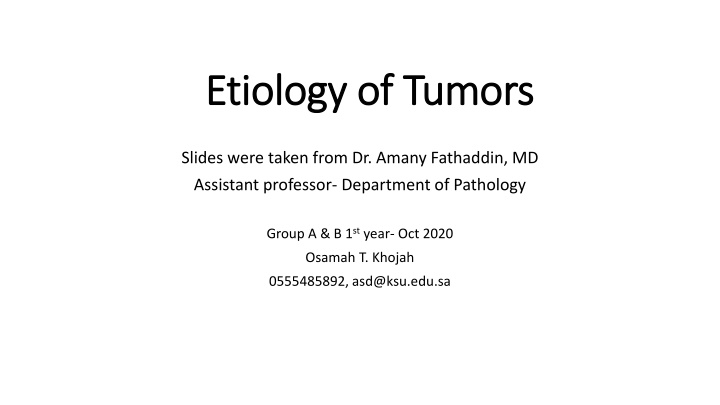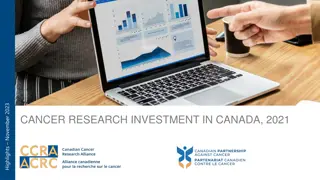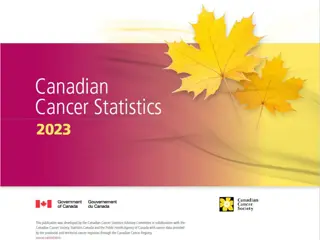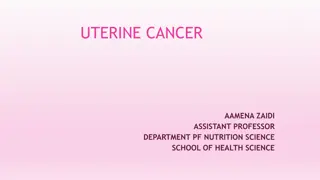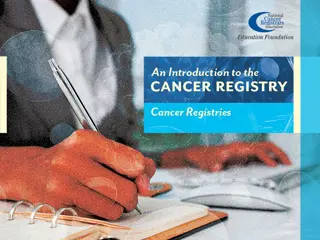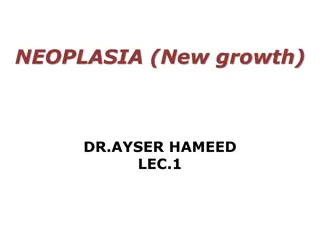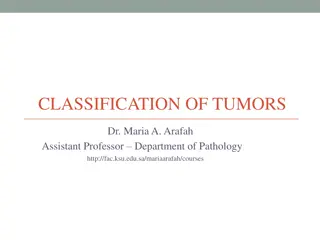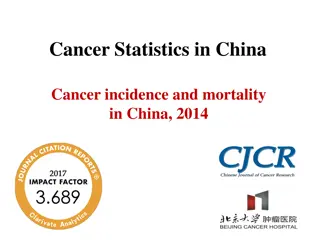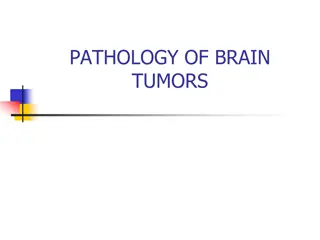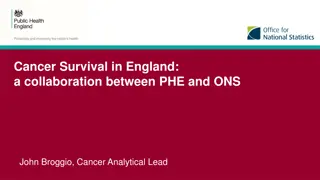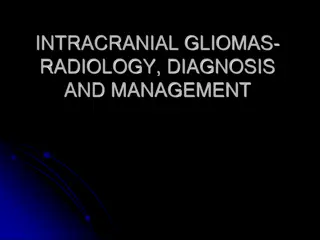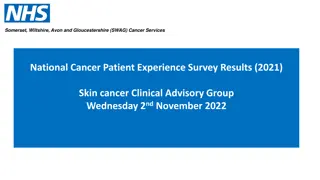Etiology of Tumors and Cancer Incidence
The etiology of tumors involves factors like age, race, genetics, and the environment. Cancer incidence varies geographically due to genetic predisposition and environmental influences. Learn about precancerous conditions, carcinogenesis concepts, and the impact of environmental factors on cancer rates.
Download Presentation

Please find below an Image/Link to download the presentation.
The content on the website is provided AS IS for your information and personal use only. It may not be sold, licensed, or shared on other websites without obtaining consent from the author.If you encounter any issues during the download, it is possible that the publisher has removed the file from their server.
You are allowed to download the files provided on this website for personal or commercial use, subject to the condition that they are used lawfully. All files are the property of their respective owners.
The content on the website is provided AS IS for your information and personal use only. It may not be sold, licensed, or shared on other websites without obtaining consent from the author.
E N D
Presentation Transcript
Etiology of Tumors Etiology of Tumors Slides were taken from Dr. Amany Fathaddin, MD Assistant professor- Department of Pathology Group A & B 1styear- Oct 2020 Osamah T. Khojah 0555485892, asd@ksu.edu.sa
Objectives Objectives Understand that incidence of cancer varies with age, race, geographic and genetic factor. Explain the categories of genetic predisposition to cancer. Identify the precancerous conditions. Know the concept of chemical, radiation and microbiological carcinogenesis.
Cancer Incidence Cancer Incidence
Cervical Cancer Cervical Cancer The declining death rate from cervical cancer: is directly related to widespread use of cytological smear studies for early detection of this tumor and its precursor lesions. The development of the human papillomavirus (HPV) vaccine may eliminate this cancer altogether in the coming years.
Geographic and Environmental Variables Geographic and Environmental Variables environmental factors are the predominant cause of the most common sporadic cancers. For example, death rates from breast cancer are about four to five times higher in the United States and Europe than in Japan. Conversely, the death rate for stomach carcinoma in men and women is about seven times higher in Japan than in the United States. Nearly all the evidence indicates that these geographic differences are environmental rather than genetic in origin.
Environmental Factors Environmental Factors Among the possible environmental influences, the most distressing in terms of prevention are those incurred in personal practices, notably cigarette smoking and chronic alcohol consumption.
Age Age In general, the frequency of cancer increases with age. 1. The rising incidence with age may be explained by the accumulation of somatic mutations associated with the emergence of malignant neoplasms. 2. The decline in immune competence that accompanies aging also may be a factor. Cancer causes slightly more than 10% of all deaths among children younger than 15 years . The major lethal cancers in children are leukemias, tumors of the central nervous system, lymphomas, and soft tissue and bone sarcomas.
Heredity Heredity Hereditary forms of cancer can be divided into three categories based on their pattern of inheritance: 1-Autosomal Dominant Cancer Syndromes. 2-Autosomal Recessive Syndromes of Defective DNA Repair. 3-Familial Cancers of Uncertain Inheritance.
Autosomal Dominant Cancer Syndromes Autosomal Dominant Cancer Syndromes Include several well-defined cancers in which inheritance of a single mutant gene greatly increases the risk of developing a tumor. The predisposition to these tumors shows an autosomal dominant pattern of inheritance. Childhood retinoblastoma is the most striking example of this category. Approximately 40% of retinoblastomas are familial. Inherited disabling mutations in a tumor suppressor gene are responsible for the development of this tumor in families. Carriers of this gene have a 10,000-fold increased risk of developing retinoblastoma. Unlike those with sporadic retinoblastoma, patients with familial retinoblastoma develop bilateral tumors, and they also have a greatly increased risk of developing a second cancer, particularly osteosarcoma.
Autosomal Recessive Syndromes of Autosomal Recessive Syndromes of Defective DNA Repair Defective DNA Repair A group of rare autosomal recessive disorders is collectively characterized by chromosomal or DNA instability and high rates of certain cancers. One of the best-studied is xeroderma pigmentosum, in which DNA repair is defective.
Familial Cancers of Uncertain Inheritance Familial Cancers of Uncertain Inheritance Virtually all the common types of cancers that occur sporadically have been reported to occur in familial forms where the pattern of inheritance is unclear. Examples are carcinomas of colon, breast, ovary, and brain. Features that characterize familial cancers include early age at onset, tumors arising in two or more close relatives of the index case, and sometimes multiple or bilateral tumors. Familial cancers are not associated with specific marker phenotypes.
Acquired Pre Acquired Pre- -neoplastic Lesions neoplastic Lesions Precursor lesions arise in the setting of chronic tissue injury or inflammation, which may increase the likelihood of malignancy by stimulating continuing regenerative proliferation or by exposing cells to byproducts of inflammation, both of which can lead to somatic mutations. Clinically, these precursor lesions are important to recognize, because their removal or reversal may prevent the development of a cancer. A brief listing of some of the chief precursor lesions follows: Squamous metaplasia and dysplasia of the bronchial mucosa, seen in habitual smokers, a risk factor for lung cancer Endometrial hyperplasia and dysplasia, seen in women with unopposed estrogenic stimulation, a risk factor for endometrial carcinoma Leukoplakia of the oral cavity, vulva, or penis, which may progress to squamous cell carcinoma. Villous adenomas of the colon, associated with a high risk of transformation to colorectal carcinoma.
ETIOLOGY OF CANCER: CARCINOGENIC AGENTS ETIOLOGY OF CANCER: CARCINOGENIC AGENTS Chemicals. Radiant Energy. Microbial Agents.
Chemicals Chemicals Direct-Acting Agents: Require no metabolic conversion to become carcinogenic. They are in general weak carcinogens but are important because some of them are cancer chemotherapy drugs (e.g., alkylating agents) used in regimens that may cure certain types of cancer (e.g., Hodgkin lymphoma), only to evoke a subsequent, second form of cancer. Indirect-Acting Agents: chemicals that require metabolic conversion to an ultimate carcinogen. For example, benzo[a]pyrene and other carcinogens are formed in the high- temperature combustion of tobacco in cigarette smoking. These products are implicated in the causation of lung cancer in cigarette smokers. Polymorphisms of endogenous enzymes such as cytochrome P-450 may influence carcinogenesis.
Mechanisms of Action of Chemical Carcinogens Mechanisms of Action of Chemical Carcinogens All direct and ultimate carcinogens contain highly reactive electrophile groups that form chemical adducts with DNA, as well as with proteins and RNA. Although any gene may be the target of chemical carcinogens, the commonly mutated oncogenes and tumor suppressors, such as RAS and TP53, are important targets of chemical carcinogens. Carcinogenicity of some chemicals is augmented by subsequent administration of promoters (e.g., phorbol esters, hormones, phenols, certain drugs) that by themselves are non-tumorigenic. To be effective, repeated or sustained exposure to the promoter must follow the application of the mutagenic chemical, or initiator.
Radiation Carcinogenesis Radiation Carcinogenesis Radiation, whatever its source (UV rays of sunlight, x-rays, nuclear fission, radionuclides) is an established carcinogen. The oncogenic properties of ionizing radiation are related to its mutagenic effects; it causes chromosome breakage, translocations, and, less frequently, point mutations. Biologically, double-stranded DNA breaks seem to be the most important form of DNA damage caused by radiation.
Radiation Carcinogenesis Radiation Carcinogenesis Natural UV radiation derived from the sun can cause skin cancers (melanomas, squamous cell carcinomas, and basal cell carcinomas). Of particular relevance to carcinogenesis is the ability to damage DNA by forming pyrimidine dimers. This type of DNA damage is repaired by the nucleotide excision repair pathway. With extensive exposure to UV light, the repair systems may be overwhelmed, and skin cancer results. Inherited disease xeroderma pigmentosum have a defect in the nucleotide excision repair pathway. As expected, there is a greatly increased predisposition to skin cancers in this disorder.
Viral and Microbial Oncogenesis Viral and Microbial Oncogenesis Oncogenic RNA viruses: Human T-cell lymphotropic virus (HTLV-1) is associated with a form of T cell leukemia/lymphoma that is endemic in certain parts of Japan and the Caribbean basin but is found sporadically elsewhere. HTLV-1 has tropism for CD4+ T cells, and this subset of T cells is the major target for neoplastic transformation. Human infection requires transmission of infected T cells through sexual intercourse, blood products, or breastfeeding. Leukemia develops only in about 3% to 5% of infected persons after a long latent period of 20 to 50 years.
Human T Human T- -cell Lymphotropic Virus cell Lymphotropic Virus The HTLV-1 genome encodes a viral TAX protein, which turns on genes for cytokines and their receptors in infected T cells. This sets up autocrine and paracrine signaling loops that stimulate T cell proliferation. Although this proliferation initially is polyclonal, the proliferating T cells are at increased risk for secondary mutations that lead to the outgrowth of a monoclonal leukemia.
Viral and Microbial Oncogenesis Viral and Microbial Oncogenesis Oncogenic DNA Viruses: Four DNA viruses: HPV, Epstein-Barr virus (EBV or HHV-4), Kaposi sarcoma herpesvirus (KSHV, also called human herpesvirus-8 [HHV- 8]), and hepatitis B virus (HBV) are strongly associated with human cancer.
Human Papillomavirus Human Papillomavirus HPV is associated with benign warts (Low risk HPV e.g. types 6 & 11), as well as cervical cancer ( High risk HPV e.g. types 16 & 18). The oncogenicity of HPV is related to the expression of two viral oncoproteins, E6 and E7; they bind to Rb and p53, respectively, neutralizing their function. E6 and E7 from high-risk strains of HPV (which give rise to cancers) have higher affinity for their targets than do E6 and E7 from low-risk strains of HPV (which give rise to benign warts).
Epstein Epstein- -Barr Virus Barr Virus EBV is implicated in the pathogenesis of a diverse list of tumors, including Burkitt s lymphoma, B cell lymphomas in patients with defective T cell immunity (e.g., those infected with HIV), a subset of Hodgkin lymphoma, nasopharyngeal carcinoma, a subset of T cell lymphomas, gastric carcinomas, NK cell lymphomas, and even mainly in the immunosuppressed. Burkitt lymphoma is endemic in certain parts of Africa and is sporadic elsewhere. Certain EBV gene products contribute to oncogenesis by stimulating a normal B cell proliferation pathway. Concomitant compromise of immune competence allows sustained B cell proliferation, leading eventually to development of lymphoma, with occurrence of additional mutations such as t(8;14) leading to activation of the MYC gene. even, in rare instances, sarcomas,
Hepatitis B and Hepatitis C Viruses Hepatitis B and Hepatitis C Viruses Between 70% and 85% of hepatocellular carcinomas worldwide are due to infection with HBV or HCV. The oncogenic effects of HBV and HCV are multifactorial, but the dominant effect seems to be immunologically mediated chronic inflammation, with hepatocellular injury, stimulation of hepatocyte proliferation, and production of reactive oxygen species that can damage DNA. The HBx protein of HBV and the HCV core protein can activate a variety of signal transduction pathways that also may contribute to carcinogenesis.
Helicobacter pylori Helicobacter pylori H. pylori infection has been implicated in both gastric adenocarcinoma and MALT lymphoma. The mechanism of H. pylori induced gastric cancers is multifactorial, including immunologically mediated chronic inflammation, stimulation of gastric cell proliferation, and production of reactive oxygen species that damage DNA (like HBV & HCV). H. pylori pathogenicity genes, such as CagA, also may contribute by stimulating growth factor pathways. It is thought that H. pylori infection leads to polyclonal B cell proliferations and that eventually a monoclonal B cell tumor (MALT lymphoma) emerges as a result of accumulation of mutations.
Summary Summary The incidence of cancer varies with age, race, geographic factors and genetic background. Most cancers are sporadic but some are familial. Predisposition to hereditary cancers may be autosomal dominant or autosomal recessive. Some acquired disease (pre-neoplastic disorders) are known to be associated with an increased risk of cancer. Three classes of carcinogenic agents have been identified: chemicals, radiation and viral and microbial agents.
